display Citroen BERLINGO MULTISPACE 2015 2.G User Guide
[x] Cancel search | Manufacturer: CITROEN, Model Year: 2015, Model line: BERLINGO MULTISPACE, Model: Citroen BERLINGO MULTISPACE 2015 2.GPages: 298, PDF Size: 12.69 MB
Page 52 of 298
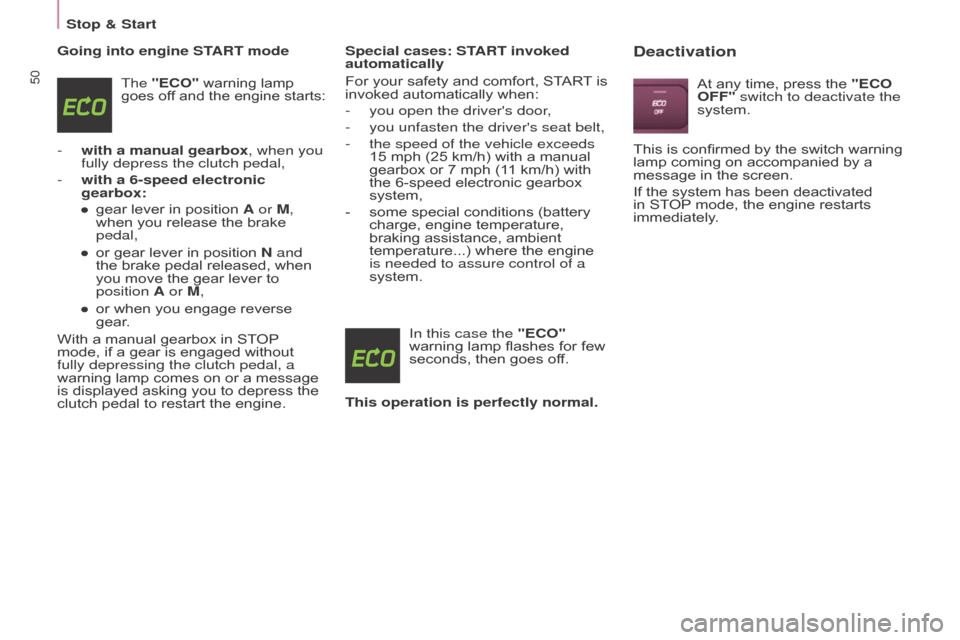
Berlingo-2-VP_en_Chap03_Pret-a-partir_ed01-2015
50
Going into engine START mode
The "ECO" warning lamp goes off and the engine starts:
- with a manual gearbox , when you
fully depress the clutch pedal,
-
with
a 6-speed electronic
gearbox:
●
gear
lever in position A or M,
when
you release the brake
pedal,
●
or
gear lever in position N and
the
brake pedal released, when
you
move the gear lever to
position
A or M,
●
or
when you engage reverse
gear
.
With
a manual gearbox in STOP
mode,
if a gear is engaged without
fully depressing the clutch pedal, a
warning
lamp comes on or a message
is
displayed asking you to depress the
clutch
pedal to restart the engine.Special cases: START invoked
automatically
For
your safety and comfort, START
is
invoked
automatically when:
-
you open the driver's door
,
-
you unfasten the driver's seat belt,
-
the speed of the vehicle exceeds
15
mph (25 km/h) with a manual
gearbox
or 7 mph (11 km/h) with
the
6-speed electronic gearbox
system,
-
some
special conditions (battery
charge,
engine temperature,
braking
assistance, ambient
temperature...)
where the engine
is needed to assure control of a
system.In this case the
"ECO"
warning
lamp flashes for few
seconds,
then goes off.
This operation is perfectly normal.
Deactivation
At any time, press the "ECO
OFF" switch to deactivate the
system.
This
is
confirmed by the switch warning
lamp
coming on accompanied by a
message
in the screen.
If
the
system has been deactivated
in
STOP
mode, the engine restarts
immediately
.
Stop & Start
Page 62 of 298
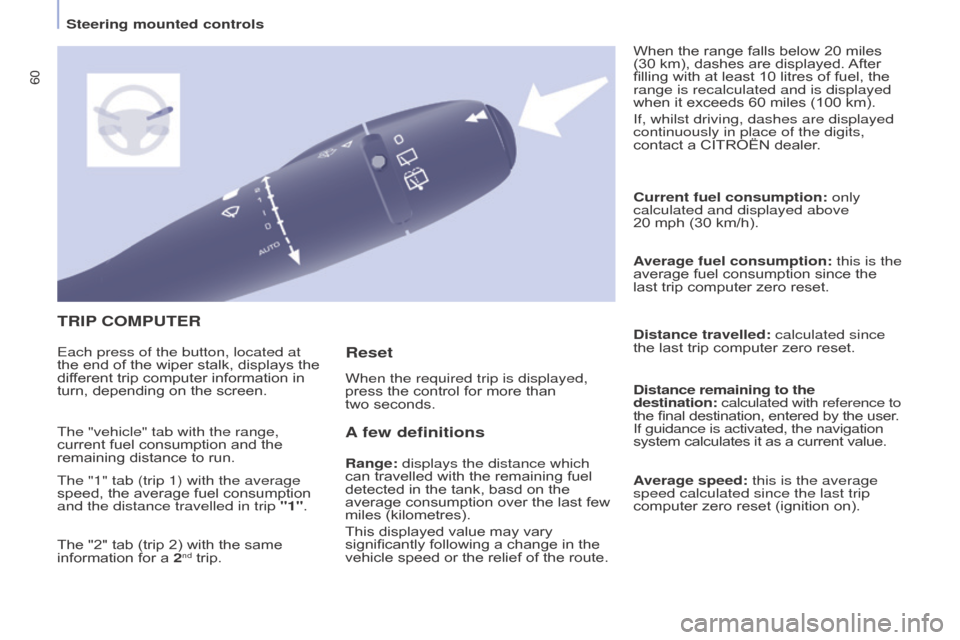
60
Berlingo-2-VP_en_Chap04_Ergonomie_ed01-2015
TRIP COMPUTER
A
few definitions
Range: displays the distance which
can travelled with the remaining fuel
detected
in the tank, basd on the
average
consumption over the last few
miles
(kilometres).
This
displayed value may vary
significantly
following a change in the
vehicle
speed or the relief of the route.Current fuel consumption:
only
calculated and displayed above
20 mph (30 km/h).
Average fuel consumption: this is the
average fuel consumption since the
last
trip computer zero reset.
Distance travelled: calculated since
the last trip computer zero reset.
Distance remaining to the
destination: calculated with reference to
the final destination, entered by the user.
If guidance is activated, the navigation
system calculates it as a current value.
Average speed: this is the average
speed calculated since the last trip
computer
zero reset (ignition on).
Each press of the button, located at
the
end
of
the
wiper
stalk,
displays
the
dif
ferent
trip
computer
information
in
turn,
depending
on
the
screen.
When the required trip is displayed,
press the control for more than
two seconds. When
the range falls below 20 miles
(30
km), dashes are displayed.
After
fillin
g with at least 10 litres of fuel, the
range is recalculated and is displayed
when
it exceeds 60 miles (100 km).
If, whilst driving, dashes are displayed
continuously in place of the digits,
contact a CITROËN dealer.
The "vehicle" tab with the range,
current
fuel
consumption
and
the
remaining
distance
to
run.
The "1" tab (trip 1) with the average
speed,
the
average
fuel
consumption
and the distance travelled in trip
"1".
The
"2"
tab
(trip
2)
with
the
same
information
for
a
2
nd trip.
Reset
Steering mounted controls
Page 63 of 298

61
Berlingo-2-VP_en_Chap04_Ergonomie_ed01-2015
CRUISE CONTROL
"CRUISE"
"This is the speed at which the driver
wishes to drive".
This
aid to driving in free-flowing
traffic
enables the vehicle to maintain
the
speed programmed by the driver,
unless
a steep gradient makes this
impossible.
For
the system to be programmed or
activated,
the vehicle speed must be
greater
than 25 mph (40 km/h) with
4th gear
or higher engaged. The
state of the cruise control system
can
be seen in the instrument panel
together
with the the programmed
speed
setting.
Function selected,
display of the "Cruise
Control" symbol.
Function off
OFF
Function on
Vehicle speed above,
the programmed
speed
flashes.
o
perating fault
detected,
OFF - the dashes
flash.
1.
Cruise
control
mode
On
/
Off.
2.
Reduce
cruise
speed
setting.
3.
Increase
cruise
speed
setting.
4.
Pause
/
Resume
cruise
control.
Steering mounted controls
EASE OF USE and COMFORT
4
Page 66 of 298
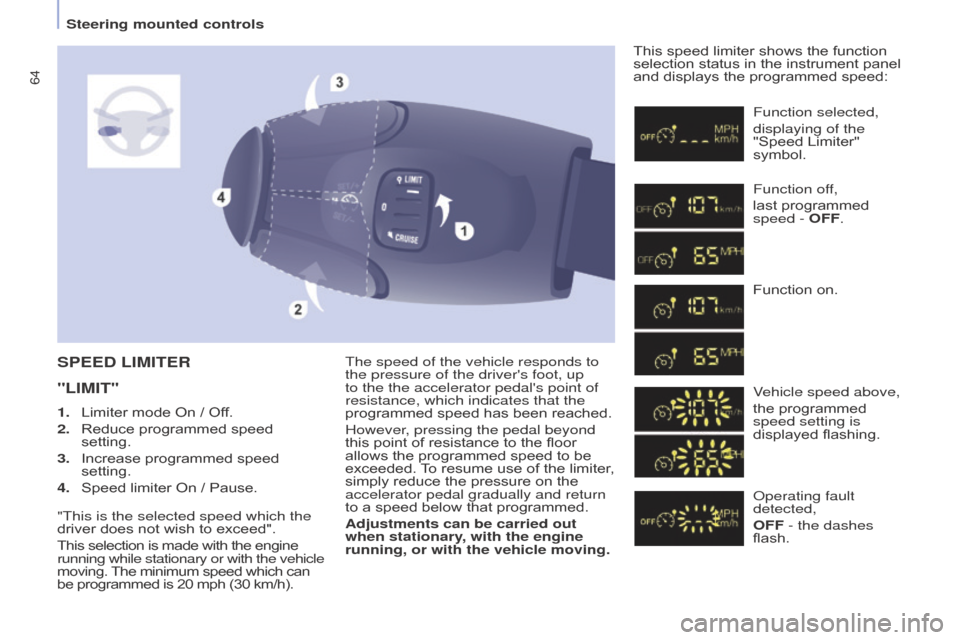
64
Berlingo-2-VP_en_Chap04_Ergonomie_ed01-2015
The speed of the vehicle responds to
the pressure of the driver's foot, up
to the the accelerator pedal's point of
resistance, which indicates that the
programmed speed has been reached.
However, pressing the pedal beyond
this
point of resistance to the floor
allows
the programmed speed to be
exceeded.
T
o resume use of the limiter,
simply
reduce the pressure on the
accelerator pedal gradually and return
to
a speed below that programmed.
Adjustments can be carried out
when stationary, with the engine
running, or with the vehicle moving. This
speed limiter shows the function
selection
status in the instrument panel
and
displays the programmed speed:SPEED LIMITER
"LIMIT"
Function selected,
displaying of the
"Speed
Limiter"
symbol.
Function of
f,
last
programmed
speed -
OFF.
Function
on.
Vehicle speed above,
the
programmed
speed setting is
displayed
flashing.
o
perating fault
detected,
OFF - the dashes
flash.
1.
Limiter
mode
On
/
Off.
2.
Reduce
programmed
speed
setting.
3.
Increase
programmed
speed
setting.
4.
Speed
limiter
On
/
Pause.
"This is the selected speed which the
driver
does
not
wish
to
exceed".
This
selection
is
made
with
the
engine
running while stationary or with the vehicle
moving.
The
minimum
speed
which
can
be
programmed
is
20
mph
(30
km/h).
Steering mounted controls
Page 71 of 298
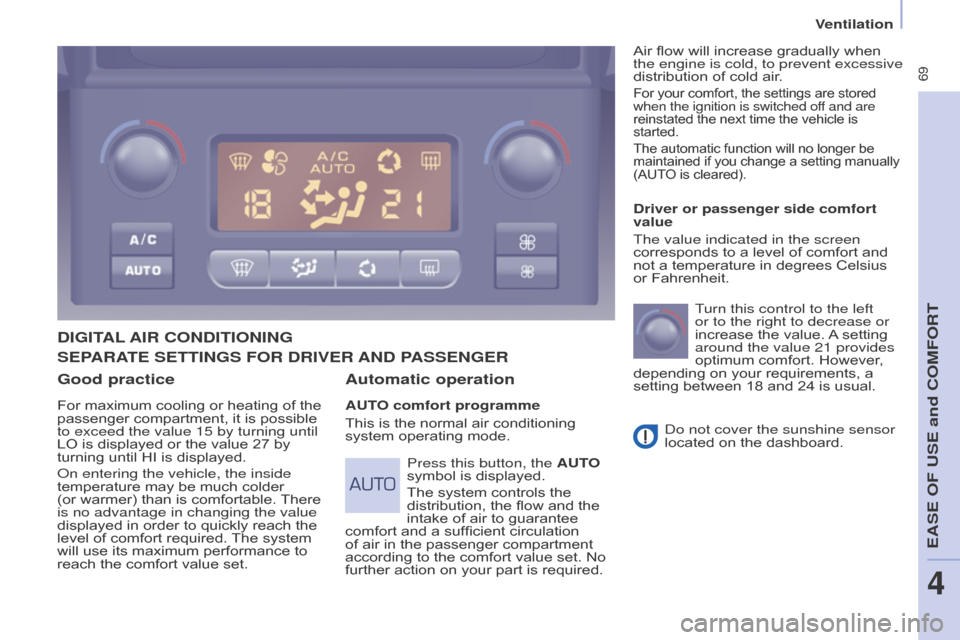
69
Berlingo-2-VP_en_Chap04_Ergonomie_ed01-2015Berlingo-2-VP_en_Chap04_Ergonomie_ed01-2015
Good practice
For maximum cooling or heating of the passenger compartment, it is possible
to exceed the value 15 by turning until
LO
is displayed or the value 27 by
turning
until HI is displayed.
o
n entering the vehicle, the inside
temperature
may be much colder
(or
warmer) than is comfortable.
There
is no advantage in changing the value
displayed
in order to quickly reach the
level
of comfort required.
The
system
will
use its maximum performance to
reach
the comfort value set.
DIGITAL AIR CONDITIONING
Automatic operation
AUTO comfort programme
This
is the normal air conditioning
system
operating mode. Driver or passenger side comfort
value
The value indicated in the screen
corresponds
to a level of comfort and
not
a temperature in degrees Celsius
or
Fahrenheit.
Turn this control to the left
or to the right to decrease or
increase the value.
A
setting
around the value 21 provides
optimum
comfort. However,
depending
on your requirements, a
setting
between 18 and 24 is usual.
d
o not cover the sunshine sensor
located
on the dashboard.
Press this button, the AUTO
symbol
is displayed.
The
system controls the
distribution,
the flow and the
intake
of air to guarantee
comfort
and a sufficient circulation
of
air in the passenger compartment
according
to the comfort value set. No
further
action on your part is required.Air
flow will increase gradually when
the
engine is cold, to prevent excessive
distribution of cold air.
For your comfort, the settings are stored when the ignition is switched of
f and are
reinstated
the next time the vehicle is
started.
The
automatic function will no longer be
maintained
if you change a setting manually
(AUT
O is cleared).
SEPARATE SETTINGS FOR DRIVER AND PASSENGER
EASE OF USE and COMFORT
4
Ventilation
Page 72 of 298
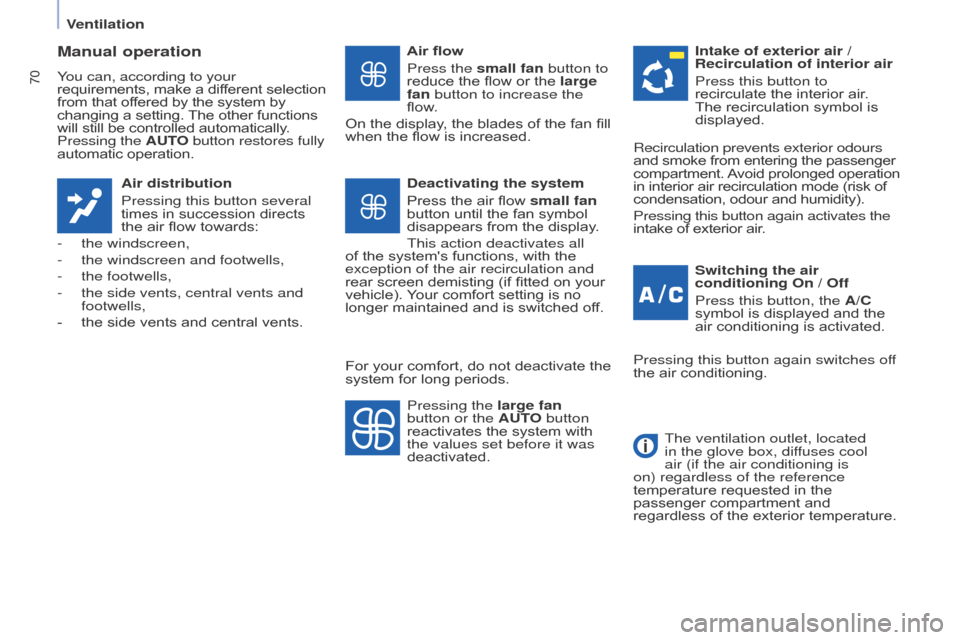
70
Berlingo-2-VP_en_Chap04_Ergonomie_ed01-2015Berlingo-2-VP_en_Chap04_Ergonomie_ed01-2015
Manual operation
You can, according to your
requirements, make a different selection from
that offered by the system by
changing
a setting.
The
other functions
will
still be controlled automatically.
Pressing the
AUTO button restores fully
automatic
operation.
Air distribution
Pressing this button several
times
in succession directs
the
air flow towards:
-
the windscreen,
-
the windscreen and footwells,
-
the footwells,
-
the side vents, central vents and
footwells,
-
the
side vents and central vents.Air flow
Press the small fan button to
reduce
the flow or the large
fan button to increase the
flow.
On
the display, the blades of the fan fill
when
the flow is increased.
Switching the air
conditioning On / Off
Press this button, the A/C
symbol
is displayed and the
air
conditioning is activated.
Deactivating the system
Press
the air flow small fan
button
until the fan symbol
disappears
from the display.
This action deactivates all
of
the system's functions, with the
exception of the air recirculation and
rear
screen demisting (if fitted on your
vehicle).
Y
our comfort setting is no
longer
maintained and is switched off.Intake of exterior air /
Recirculation of interior air
Press this button to
recirculate
the interior air.
The
recirculation symbol is
displayed.
Pressing the
large fan
button or the AUTO button
reactivates
the system with
the values set before it was
deactivated.Recirculation prevents exterior odours
and
smoke from entering the passenger
compartment.
A
void prolonged operation
in
interior air recirculation mode (risk of
condensation,
odour and humidity).
Pressing this button again activates the
intake
of exterior air.
Pressing this button again switches off
the
air conditioning.
The ventilation outlet, located
in the glove box, diffuses cool
air (if the air conditioning is
on) regardless of the reference
temperature
requested in the
passenger
compartment and
regardless
of the exterior temperature.
For
your comfort, do not deactivate the
system
for long periods.
Ventilation
Page 114 of 298
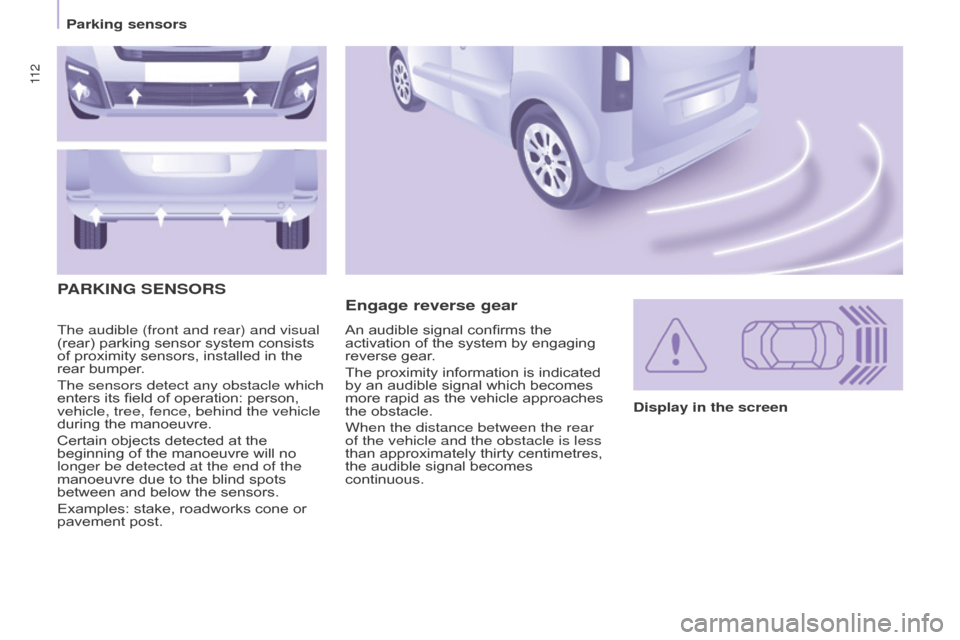
11 2
Berlingo-2-VP_en_Chap05_Securite_ed01-2015
The audible (front and rear) and visual
(rear) parking sensor system consists
of
proximity sensors, installed in the
rear
bumper.
The sensors detect any obstacle which
enters
its field of operation: person,
vehicle, tree, fence, behind the vehicle
during
the manoeuvre.
Certain
objects detected at the
beginning
of the manoeuvre will no
longer be detected at the end of the
manoeuvre
due to the blind spots
between
and below the sensors.
Examples:
stake, roadworks cone or
pavement
post.
Engage reverse gear
P
ARKING
SENSORS
Display in the screen
An
audible
signal
confirms
the
activation
of
the
system
by
engaging
reverse
gear.
The
proximity
information
is
indicated
by
an
audible
signal
which
becomes
more
rapid
as
the
vehicle
approaches
the
obstacle.
When the distance between the rear
of the vehicle and the obstacle is less
than
approximately
thirty
centimetres,
the
audible
signal
becomes
continuous.
Parking sensors
Page 116 of 298
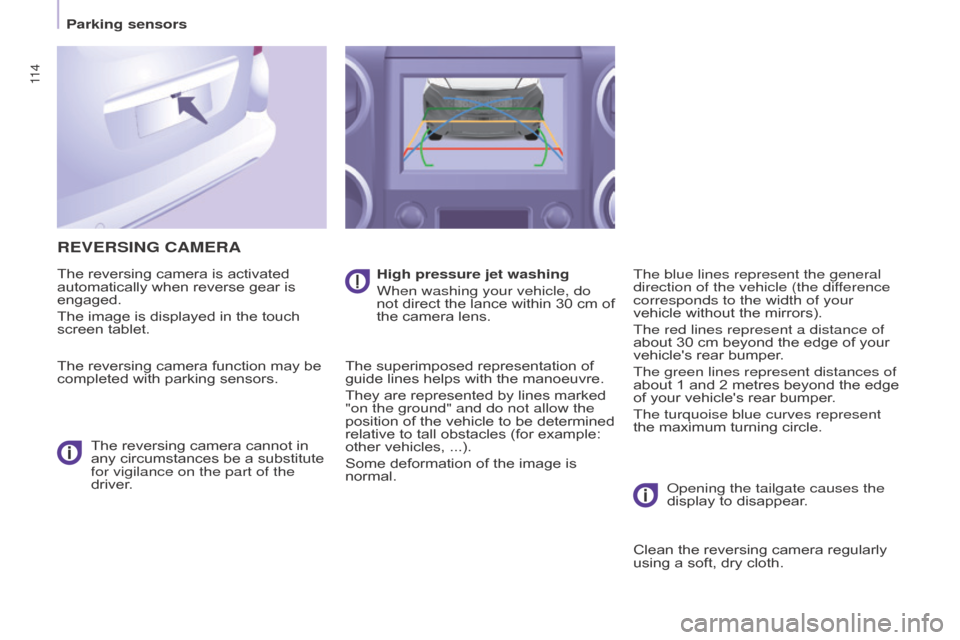
11 4
Berlingo-2-VP_en_Chap05_Securite_ed01-2015
REVERSING CAMERA
The reversing camera is activated automatically when reverse gear is
engaged.
The
image is displayed in the touch
screen
tablet.
The
reversing camera function may be
completed
with parking sensors.
The
reversing camera cannot in
any
circumstances be a substitute
for vigilance on the part of the
driver
. High pressure jet washing
When washing your vehicle, do
not
direct
the
lance
within
30
cm
of
the
camera lens.
The
superimposed representation of
guide
lines helps with the manoeuvre.
They
are represented by lines marked
"on the ground" and do not allow the
position
of the vehicle to be determined
relative
to tall obstacles (for example:
other
vehicles, ...).
Some
deformation of the image is
normal.The blue lines represent the general
direction of the vehicle (the dif
ference
corresponds to the width of your
vehicle
without the mirrors).
The red lines represent a distance of
about
30 cm beyond the edge of your
vehicle's
rear bumper.
The green lines represent distances of
about
1 and 2 metres beyond the edge
of
your vehicle's rear bumper.
The turquoise blue curves represent
the
maximum turning circle.
o
pening the tailgate causes the
display
to disappear.
Clean
the reversing camera regularly
using
a soft, dry cloth.
Parking sensors
Page 122 of 298

120
Berlingo-2-VP_en_Chap05_Securite_ed01-2015
Operation
When your vehicle is too close to or
approaches the vehicle ahead too
quickly the system automatically
applies
the brakes to avoid a collision.
You are then alerted by the display of a
message.
The
brake lamps on your vehicle come
on
to warn other road users.
The collision can be avoided
automatically
if the difference in
speed between your vehicle and the
vehicle
ahead does not exceed 9 mph
(15 km/h).
Above
this threshold, the system will
do what is possible to avoid or reduce
the accident by lowering the speed of
impact.
The
automatic braking may bring
the
vehicle to a complete stop if the
situation
requires it.
In this case, the vehicle is held
stationary
temporarily (for about
1.5 seconds)
to allow the driver to take
back
control by pressing the brake
pedal. The
triggering of the system may cause the engine to stall, unless
the driver depresses the clutch
pedal
quickly enough during automatic
braking.
During
automatic braking, the
driver can always obtain a higher
rate of deceleration than that
controlled
by the system, by pressing
firmly
on the brake pedal.
After
an impact, the system is
automatically
put out of service: it
no
longer operates.
You
must go to a CITROËN dealer or a
qualified
workshop to have the system
made
operational again.
Operating limits
The system only detects vehicles that are stationary or moving in the same
direction
as your vehicle.
It
does not detect small vehicles
(bicycles,
motorcycles),
pedestrians
or animals, nor non-
reflective
stationary objects.
The
system is not triggered or is
interrupted
if the driver:
-
accelerates strongly
-
or turns the steering wheel
suddenly
(avoiding manoeuvre).
In
difficult weather conditions (very
heavy
rain, snow, fog, hail...),
braking
distances increase, which
can
reduce the ability of the system to
avoid
a collision.
The
driver must therefore remain
particularly
vigilant.
Never
leave accumulations of
snow
or any object projecting
above the bonnet or in front of
the
roof: this might fall into the field of
vision of the sensor and generate a
detection.
driving safely
Page 123 of 298

121
Berlingo-2-VP_en_Chap05_Securite_ed01-2015
Deactivation
The system is deactivated in the vehicle configuration menu, accessible
with
the ignition on.
Its
state is memorised when the
ignition
is switched off.
When
the system is deactivated,
a
message is displayed every
time
the ignition is switched on, to
warn
you. With the monochrome screen C
F
Press the
MENU button for access
to
the main menu.
F
Select "
Personalisation-
Configuration".
F
Select "
Define vehicle
parameters".
F
Select "
Driving assistance".
F
Select "
Automatic emergency
braking : OFF" or "Automatic
emergency braking : ON".
F
Press the "
7" or "8" button to
check
or uncheck the box and
activate
or deactivate the system
respectively
.
F
Press the "
5" or "6" button, then
the OK button to select the "OK"
box
and confirm or the Back button
to
cancel.With the touch screen tablet
F
Press the "MENU" button.
F Select the " Driving" menu.
F
In the secondary page, select
"
Vehicle settings".
F
Select "
Driving assistance" tab.
F
Check
or uncheck the "Automatic
emergency braking" box to
activate
or deactivate the system.
F
Confirm.
driving safely
SaFETY
5